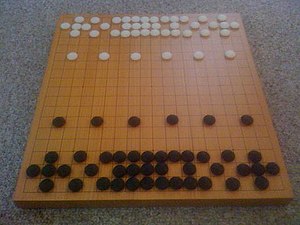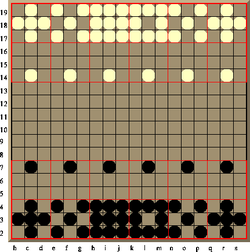Gach
Gach is a strategic board game with chess- like rules that is played on a go board and with go pieces.
history
Gach was invented by eight students of the “ Puzzles and Games Ring of the Archimedeans Mathematics Society ” at Cambridge University as Gess (an artificial word made up of Go and Chess ). The rules were first written down in 1994 by Paul Bolchover in Eureka magazine in Great Britain. It is understood as a chess variant on a go board. In Germany it was described for the first time as Gach ( Go und Schach ) by Ian Stewart in May 1995 in an issue of the spectrum of science .
Rules of the game
Game objective
The aim of the game is to destroy all opposing rings (see chess king ).
game piece
A pawn consists of a 3 × 3 square, in which there is at least one stone of one's own, but no opposing stone. This area is called the footprint of the figure; it can also be partially outside the board and must only overlap at least one field of the board.
The position of the stones in the square describes the movement possibilities of the figure. She may move in the direction that is marked with a stone in the square.
The middle position specifies the train length. If this position is occupied, the figure can move any number of spaces. If it is unoccupied, the figure may only move up to 3 spaces.
Loss of game pieces
A playing figure may only move until its footprint covers an obstacle with at least one square.
An obstacle can
- be one or more own or opposing stones.
- All stones covered by the footprint (not just by pieces) of the drawn figure are removed from the playing field. So - in contrast to chess - you are allowed to hit your own stones.
- be the edge of the field.
- If part of the footprint of the drawn piece is outside the playing field (as o on line a or t or column 1 or 20), the pieces of the piece that are outside the board are removed.
Game flow
It is drawn alternately and it is compulsory to move. You always have to make a move that changes the arrangement of the stones on the board. Black makes the first move.
The game ends when a player runs out of rings. If the drawing player himself destroys his last ring, he loses, or practically equivalent: you may not destroy your last ring (you always have a move that gets your own ring). Otherwise, if the opponent no longer has a ring after the move, the drawing player wins.
Basic setup
General
It is played on a go board with 19 horizontal and 19 vertical lines. The stones are placed on the fields delimited by the lines, and not on the intersection of the lines as in the Go. The board thus has 18 × 18 fields.
Each player starts with 43 stones. Their basic setup forms pieces that correspond to those of chess. On the back and front three rows, viewed from left to right as seen from black:
Rook - bishop - queen - ring (king) - bishop - rook
In front of it there are 6 farmers.
Description of the figures
- Symbolically through a drawing:
- Numeric by 3 octal numbers
- Here a number of the figure eight (a place) describes a row of the game figure.
- Example:
- The ring has the figure code "7-5-7".
- This results from the binary coding of the stone positions. The first row contains one stone each, which corresponds to 111 binary or 7 octal . The second row contains a stone in the first and last position (101 binary = 5 octal ) and the third row again contains a stone in each position (= 7 octal ).
ring
The ring is the most important figure in gach. It corresponds to the king in chess . It consists of 8 pieces, which are arranged in a ring around the center of the footprint . He can move in all directions, but only by a maximum of 3 spaces.
In the basic position there is a ring. Its position is in the right middle position for black and in the left middle position for white.
- Figure code: 7-5-7
lady
The queen is the most powerful piece on the field. It consists of 9 pawns, which cover all positions of the footprint . She can move as far as she likes, horizontally, vertically, and diagonally (see checkers (chess) ).
In the basic position there is a lady. It is to the left of the ring for black and to the right of the ring for white.
- Figure code: 7-7-7
runner
The runners consist of 5 pieces, which are arranged in the 4 corners of the footprint as well as in its center. You can move diagonally as far as you want across the playing field, similar to the bishop in chess .
In the basic position there are two runners. These are to the left and right of the queen and ring.
- Figure code: 5-2-5
Towers
The towers consist of 5 pieces, which are arranged like a cross in the footprint . So you can move horizontally and vertically as far as you want on the playing field, similar to the rook in chess .
There are two towers in the basic position. You are on the left and right at the edge of the playing field.
- Figure code: 2-7-2
farmers
A pawn is a pawn that only has a stone in the upper middle square. So she can only move forward 3 spaces, similar to a pawn in chess .
In the basic position there are 6 pawns. These are in front of the above figures.
- Figure code: 2-0-0
annotation
It is not compulsory to adhere to the classification of the basic figures at the opening. You can take every 3 × 3 square, in which there are only your own stones, as a figure and move them according to their stone arrangement. It is Z. B. possible to form a pawn, two thirds of which consists of the left tower and one third of the left bishop. This figure could then move as far as desired diagonally and to the left, but only one step in the basic position, since stones are then already covered by the figure's footprint.
Theoretically 512 figures would be possible. However, the two possible figures 0-0-0 and 0-2-0 are
not possible in the game, as they do not contain any directional stones . This leaves 510 different figures, many of which emerge from others through rotations and reflections. A single stone (pawn) can move in any direction if there is enough space around its position. For this only the center of the footprint has to be chosen differently. So it corresponds to 8 different "figures".
Summary of the rules
The two players take turns drawing. There is a train obligation. First, choose a 3 × 3 square (footprint). This may only contain your own stones. At least one of these must be on the edge of the square. Only at least one field of the square must be on the playing field (18 × 18 fields). This square, together with the stones it contains, is moved in a direction in which a stone is at the edge of the square, relative to its central field. If the middle field is occupied, you can move as far as you want, otherwise a maximum of three fields. The square may only be pulled until it overlaps another stone, or until a stone in the square is pushed off the board. Own and opponent's stones that are overlapped or pushed off the board are captured. The loser of the game is the player who no longer has a ring , which is a 3 × 3 square with eight stones belonging to the player in question and a free midfield.
notation
The game notation of a gach game is similar to that of a chess game . The lines from b to s are labeled from left to right (viewed from black). The rows are labeled 2 to 19 from bottom to top. As a move, the position of the middle of the footprint at the beginning and at the end of the move is noted, connected with a "-". Since the center of the footprint can be outside the board at the beginning of the move, the board is extended by imaginary edge lines (denoted by a and t) and by edge rows (1 and 20).
Example of a game start:
| 1. | i6 - i9 | i15 - i12 |
| 2. | h9 - i10 | m15 - j12 |
| 3. | i3 - i10 | i18 - i12 |


